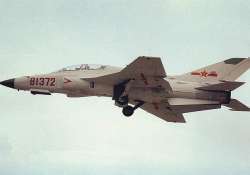China deploys supersonic trainer aircraft for pilot training
Beijing: Modernising its airforce at a rapid pace, China has introduced a third-generation supersonic trainer aircraft to its military flight schools to shorten pilots' training time and prepare them for advanced fighter jets.People's Liberation Army

Beijing: Modernising its airforce at a rapid pace, China has introduced a third-generation supersonic trainer aircraft to its military flight schools to shorten pilots' training time and prepare them for advanced fighter jets.
People's Liberation Army Air Force Aviation University deployed an undisclosed number of JL-9 Mountain Eagle two-seater trainer jets this month and has started to use them to train students, PLA Air Force's Daily, the official organ of the Chinese military, reported.
The aircraft has been developed and manufactured by Guizhou Aviation Industry Group, a subsidiary of Aviation Industry Corp of China.
It has a maximum speed of 1,837 kilometres per hour, a maximum range of 2,400 km and maximum takeoff weight of 9.8 metric tons.
PLA Daily quoted Liu Yuequan, a senior instructor at the university, as saying that the JL-9 can train pilots for both second-and third-generation fighter aircraft.
It can also perform some combat operations, Liu said.
The PLA airforce is rapidly modernising with variety of aircraft including the stealth fighter even though China still depended mostly on Russia for the aircraft engines.
Fu Qianshao, an aviation equipment expert with the PLA Air Force, told state-run China Daily yesterday, "In the past, the PLA Air Force lacked an advanced trainer aircraft, soit had to adopt the second-generation JJ-7 trainer jet to conduct advanced training for students."
The JJ-7 was developed based on the five-decade-old J-7 fighter jet, so it is suitable for training second-generation aircraft pilots, Fu said.
"However, a large proportion of our new pilots will operate third-generation J-10s, J-11s and JH-7s as soon as they join combat units. An advanced trainer aircraft was needed badly to connect flight students with our top fighter jets," he said.
Introduction of the JL-9 will enable the air force to shorten the time required for flight students' advanced training and familiarise them with the third-generation aircraft they may fly after graduation, Fu added.
Wang Ya'nan, deputy editor-in-chief of Aerospace Knowledge magazine, said the JL-9 is much better than the JJ-7 in terms of control, manoeuvrability and takeoff and landing capabilities.
"Two of the most difficult things that flight students have to deal with on the antiquated JJ-7 are take offs and landings," he said.
"These take a lot of time to learn and practice but ultimately prove to be useless because the third-generation aircraft they will fly have different takeoff and landing procedures," Wang said.
"Using the JL-9 will help them to save a great deal of time in adapting to real fighter jets when they start flying them," he said.
